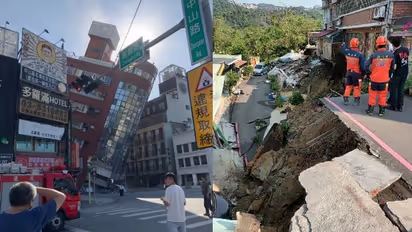Taiwan earthquake: 70 miners trapped in two coal mines as strongest tremor in 25 years rocks country

Synopsis
Taiwan's National Fire Agency reported that two coal mines in Hualien County are housing 70 miners who are currently trapped following a potent earthquake that struck the island on Wednesday.
70 coal miners remain trapped in two coal mines in Hualien County following Taiwan's most powerful earthquake in 25 years on Wednesday, as reported by the country's National Fire Agency (NFA). One coal mine holds at least 64 trapped individuals, while the other holds six, according to the agency.
The earthquake, measuring 7.2 magnitude, struck the semi-autonomous island nation just before 8 am (local time), resulting in a total of nine reported fatalities, according to Taiwan's fire agency. Among the casualties, three hikers were killed in rockslides within Taroko National Park in Hualien, and a van driver succumbed to injuries when struck by boulders in the same area. Additionally, 50 hotel workers were reported missing while en route to a national park. Rescue efforts, including the use of ladders, are underway to bring individuals to safety.
The earthquake and subsequent aftershocks resulted in injuries to 934 individuals. Moreover, the seismic activity triggered 24 landslides and inflicted damage on 35 roads, bridges, and tunnels. Traffic along the East Coast came to a halt as landslides and debris obstructed tunnels and highways, rendering them impassable.
Train services were halted across Taiwan due to twisted tracks caused by the earthquake, while the subway service in Taipei was also suspended temporarily. Despite sections of a newly constructed elevated line in Taipei splitting apart, the structures did not collapse. Initial panic subsided swiftly on the island, which conducts drills at schools and disseminates alerts through public media and mobile phones to prepare for such events.
By noon, activity resumed at the bustling metro station in Beitou, a northern Taipei suburb, with commuters heading to work and visitors arriving to enjoy hot springs or explore mountain paths near an extinct volcano's base. The Japan Meteorological Agency reported a tsunami measuring 30 centimeters (about 1 foot) on the coast of Yonaguni island approximately 15 minutes after the quake. Tsunami advisories were issued in Japan and the Philippines but were later lifted.
The earthquake's effects were also felt in Shanghai and various provinces along China's southeastern coast, according to Chinese media. Taiwan and China are approximately 160 kilometers (100 miles) apart. Situated along the Pacific "Ring of Fire," Taiwan is positioned on the line of seismic faults encircling the Pacific Ocean, where a majority of the world's earthquakes occur.
Videos shared by the Taoyuan Scenic Area Service Agency on its social media depicted trees swaying and suspension lines on a bridge trembling as the earthquake struck. Television footage captured neighbors and rescue teams assisting residents, including a toddler, out of buildings through windows and onto the streets. Although visibly shaken, all individuals seemed able to move, with no reports of serious injuries. Some doors were stuck shut due to the pressure caused by the quake's tilt.
Taiwan experiences frequent earthquakes, and its population is notably well-prepared for such events. However, authorities did not issue alerts for the recent earthquake, expecting it to be relatively mild. Despite this anticipation, the eventual tremor was strong enough to unsettle even those accustomed to such shaking.
The government regularly updates building codes to enhance earthquake resistance for both new and existing structures, a measure that may incur higher construction costs. Additionally, subsidies are provided to residents willing to assess their buildings' quake resistance. Experts attribute the relatively limited impact on the island's 23 million residents to its exceptional earthquake preparedness.
Wednesday's earthquake was the most significant since a magnitude 7.6 quake in 1999, which resulted in approximately 2,400 fatalities and extensive damage to 50,000 buildings. Since 1980, Taiwan and its surrounding waters have experienced around 2,000 earthquakes with a magnitude of 4.0 or higher, including over 100 quakes surpassing magnitude 5.5, according to data from the US Geological Survey.
Check the Breaking News Today and Latest News from across India and around the world. Stay updated with the latest World News and global developments from politics to economy and current affairs. Get in-depth coverage of China News, Europe News, Pakistan News, and South Asia News, along with top headlines from the UK and US. Follow expert analysis, international trends, and breaking updates from around the globe. Download the Asianet News Official App from the Android Play Store and iPhone App Store for accurate and timely news updates anytime, anywhere.